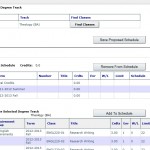When you have the results of an audit in object form, it suggests using those results within a process for class scheduling. Class scheduling involves a student and/or advisor examining the classes being offered for a term and selecting those classes that best meet the student’s needs for future graduation. Since a degree audit is the document that defines those needs, it seems reasonable that the audit could somehow be integrated as a part of the scheduling process. In fact, in the past, a print-out of the degree audit was an important piece of information to be included in the scheduling process.
In particular, since AOA provides the results of an audit in object form, the audit result is  particularly suited for the process. What we would like to do is run an audit for the student for a particular degree track and then compare the classes offered for the term against the course requirements in the audit that are yet to be met. That is exactly what is done in the scheduling option, “Registration by Audit.” (Example shown to the right.) The classes scheduled for the term are compared against the remaining course requirements from the audit and a list of classes is presented that go toward meeting necessary audit requirements. After a student has selected a “proposed schedule,” then that schedule, and the student’s current academic record are again processed through the audit for the track and the audit results are presented in the usual form for student or advisor review.
particularly suited for the process. What we would like to do is run an audit for the student for a particular degree track and then compare the classes offered for the term against the course requirements in the audit that are yet to be met. That is exactly what is done in the scheduling option, “Registration by Audit.” (Example shown to the right.) The classes scheduled for the term are compared against the remaining course requirements from the audit and a list of classes is presented that go toward meeting necessary audit requirements. After a student has selected a “proposed schedule,” then that schedule, and the student’s current academic record are again processed through the audit for the track and the audit results are presented in the usual form for student or advisor review.
This functionality allows the student or advisor to understand how the classes scheduled for a term will impact the student’s requirements for graduation. It should be noted that this functionality is entirely the result of the processing of a degree audit through a work-in-progress object, which is then used for automation of a related function.